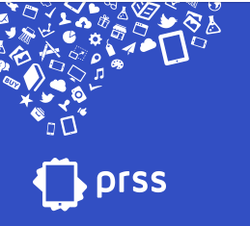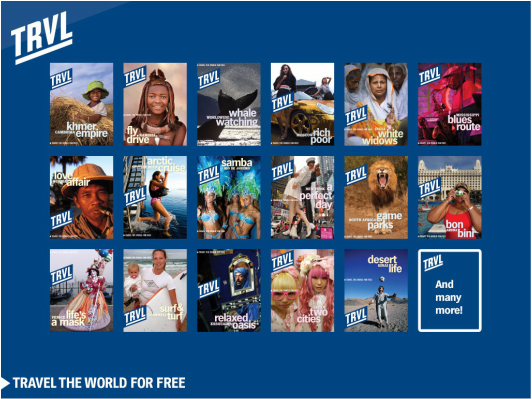
By Cecilia Galarza
Entrepreneur Michel Elings and photographer/writer Jochem Wijnands launched the award-winning iPad magazine TRVL in 2010, as part of their start-up venture based in the Netherlands. While producing this travel magazine app, they found that something was “broken” in the digital magazine production and distribution tools. Tired of the non-intuitive softwareWoodwing, its dependency on Adobe InDesign and the expensive distribution costs, they decided to develop PRSS, a more efficient platform for digital magazine design.
PRSS is user-friendly, template-driven and doesn't require programming skills. The creators optimized the file formats reusing the same image for different orientations, using algorithms to shrink size and supporting retina display. As a result, magazine pages don't take long to display, which makes the experience closer to flicking through a magazine. No need to wait for the entire issue to download to start reading. Elings and Wijnands wanted the content to stand out and the app to facilitate it. Full integration with iOS capabilities also enables a better user experience. For example, a very nice option that I tried myself in the
TRVL app is tapping on images so that a map pops up showing where the picture was taken.
The publishing tool includes real time collaboration features for writers and designers, and being web-based, changes are automatically saved.
It's no coincidence that this publishing platform is so good. It was created by a publisher, having in mind exactly what a customer would want. The developers used to be customers in the first place, and they created this tool to redesign their own magazine.
The latest news reported on September 24th is that Apple has acquired PRSS and hired the company founders and their team.
In an interview back in 2012, Elings said that with their production suite they wanted to help new publishers start their magazines, something that would democratize the market of iPad magazines in the same way that desktop publishing software such as Quark or InDesign did for self-publications in print and online. With that aim, the plan was to make PRSS free to use but charge a small fee for distribution costs. They had experienced unfair pricing with other tools and thus they didn't want the same for other publishers.
Up until now, Apple has been offering users an app called iBooks Author, which allows to create books for iPad and Mac, but doesn't have a specific tool for magazine publications. Right after the news of Apple acquiring PRSS became public, the site prss.com stopped functioning, and it seems fair to guess that Apple will build the PRSS features within iBooks. However, we will have to wait and see what pricing model is established for distribution. Hopefully it will be widely accessible for small independent publishers and revolutionize the market creating new opportunities.
These are the type of stories from the publishing industry that inspire me. Not the part where Apple bought the company, but the one about two people that had an idea for an original publication that readers would enjoy, and their determination to create a powerful tool to deliver it successfully. Anything is possible if ideas arise from the passion for creating wonderful materials and are applied to making things better.
Articles:
http://techcrunch.com/2014/09/23/prss-digital-magazine-platform-acquired-by-apple/
https://gigaom.com/2014/09/24/apple-acquires-prss-a-company-that-builds-tools-for-ipad-magazine-creation/
http://www.newsfactor.com/story.xhtml?story_id=12000BSVY0CO
http://appleinsider.com/articles/13/10/20/new-ipad-publishing-system-prss-sets-out-to-make-print-feel-stupid
https://gigaom.com/2013/07/08/prss-is-trying-to-design-the-ipad-publishing-app-that-apple-never-built/
https://gigaom.com/2012/11/02/prss-aims-to-be-a-low-cost-ipad-magazine-factory-in-the-cloud/
Entrepreneur Michel Elings and photographer/writer Jochem Wijnands launched the award-winning iPad magazine TRVL in 2010, as part of their start-up venture based in the Netherlands. While producing this travel magazine app, they found that something was “broken” in the digital magazine production and distribution tools. Tired of the non-intuitive softwareWoodwing, its dependency on Adobe InDesign and the expensive distribution costs, they decided to develop PRSS, a more efficient platform for digital magazine design.
PRSS is user-friendly, template-driven and doesn't require programming skills. The creators optimized the file formats reusing the same image for different orientations, using algorithms to shrink size and supporting retina display. As a result, magazine pages don't take long to display, which makes the experience closer to flicking through a magazine. No need to wait for the entire issue to download to start reading. Elings and Wijnands wanted the content to stand out and the app to facilitate it. Full integration with iOS capabilities also enables a better user experience. For example, a very nice option that I tried myself in the
TRVL app is tapping on images so that a map pops up showing where the picture was taken.
The publishing tool includes real time collaboration features for writers and designers, and being web-based, changes are automatically saved.
It's no coincidence that this publishing platform is so good. It was created by a publisher, having in mind exactly what a customer would want. The developers used to be customers in the first place, and they created this tool to redesign their own magazine.
The latest news reported on September 24th is that Apple has acquired PRSS and hired the company founders and their team.
In an interview back in 2012, Elings said that with their production suite they wanted to help new publishers start their magazines, something that would democratize the market of iPad magazines in the same way that desktop publishing software such as Quark or InDesign did for self-publications in print and online. With that aim, the plan was to make PRSS free to use but charge a small fee for distribution costs. They had experienced unfair pricing with other tools and thus they didn't want the same for other publishers.
Up until now, Apple has been offering users an app called iBooks Author, which allows to create books for iPad and Mac, but doesn't have a specific tool for magazine publications. Right after the news of Apple acquiring PRSS became public, the site prss.com stopped functioning, and it seems fair to guess that Apple will build the PRSS features within iBooks. However, we will have to wait and see what pricing model is established for distribution. Hopefully it will be widely accessible for small independent publishers and revolutionize the market creating new opportunities.
These are the type of stories from the publishing industry that inspire me. Not the part where Apple bought the company, but the one about two people that had an idea for an original publication that readers would enjoy, and their determination to create a powerful tool to deliver it successfully. Anything is possible if ideas arise from the passion for creating wonderful materials and are applied to making things better.
Articles:
http://techcrunch.com/2014/09/23/prss-digital-magazine-platform-acquired-by-apple/
https://gigaom.com/2014/09/24/apple-acquires-prss-a-company-that-builds-tools-for-ipad-magazine-creation/
http://www.newsfactor.com/story.xhtml?story_id=12000BSVY0CO
http://appleinsider.com/articles/13/10/20/new-ipad-publishing-system-prss-sets-out-to-make-print-feel-stupid
https://gigaom.com/2013/07/08/prss-is-trying-to-design-the-ipad-publishing-app-that-apple-never-built/
https://gigaom.com/2012/11/02/prss-aims-to-be-a-low-cost-ipad-magazine-factory-in-the-cloud/



 RSS Feed
RSS Feed